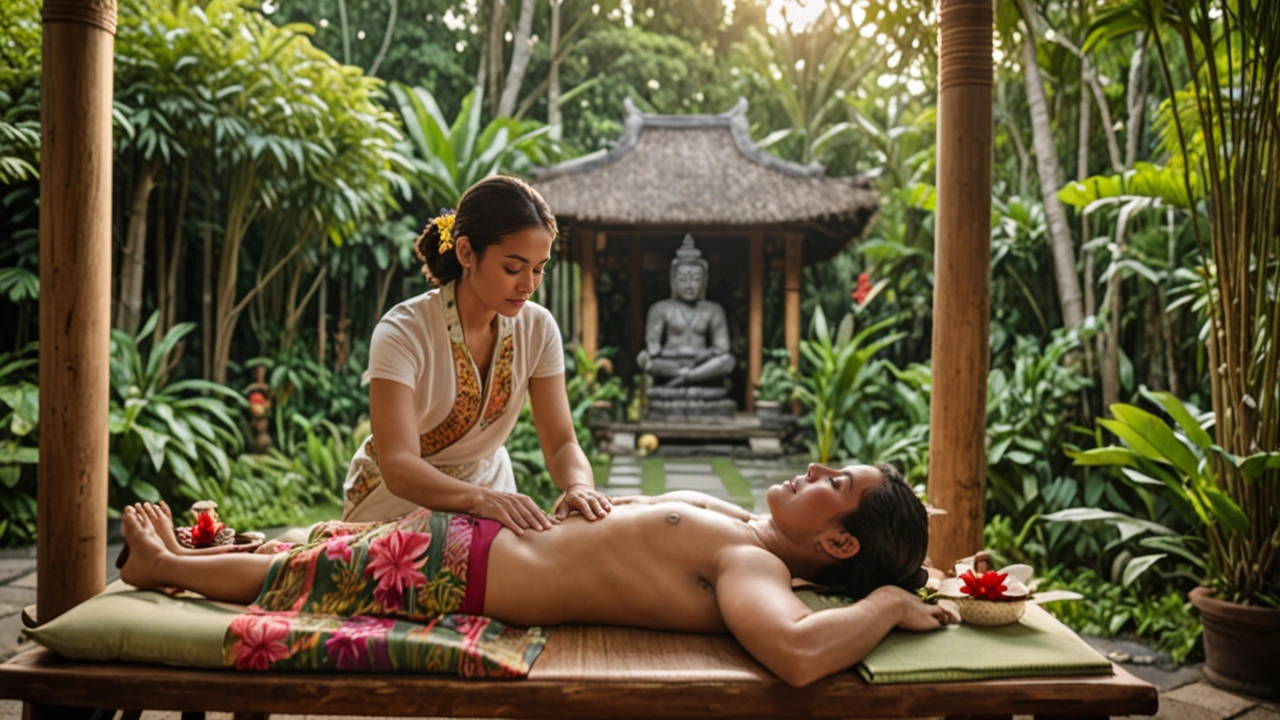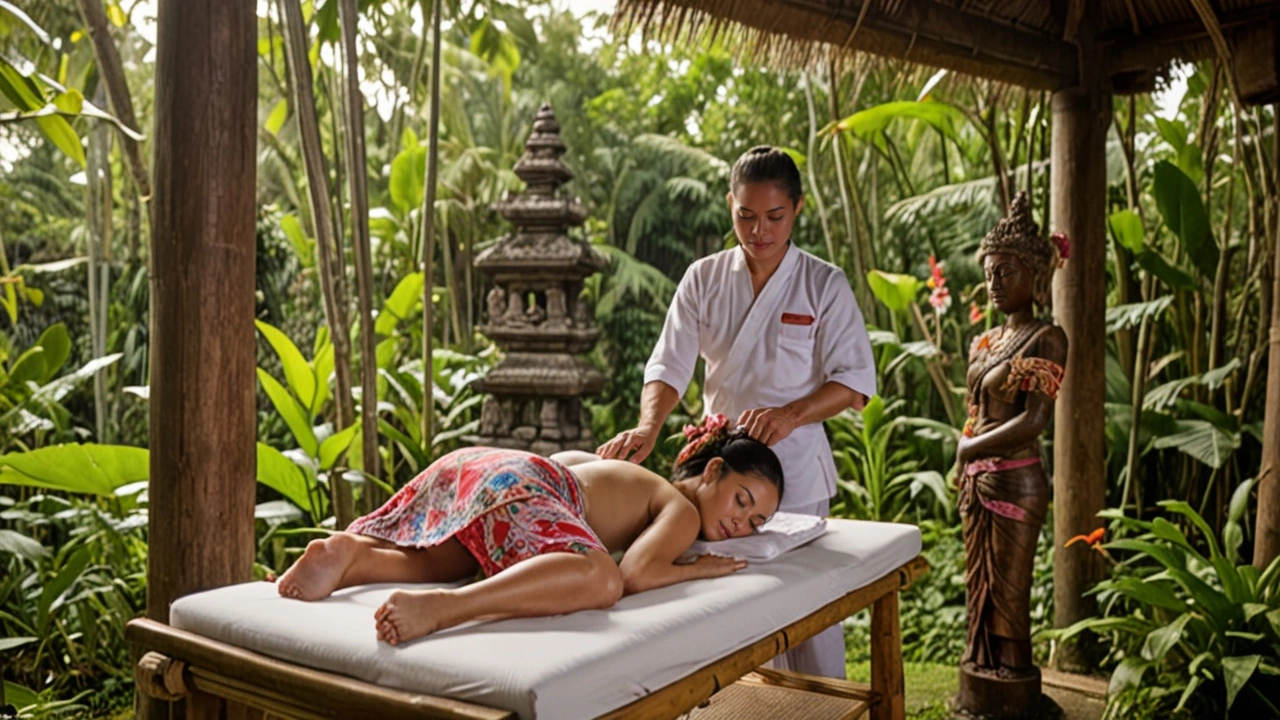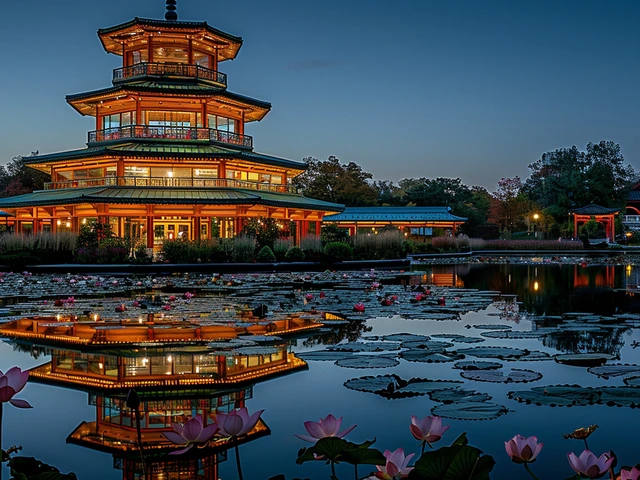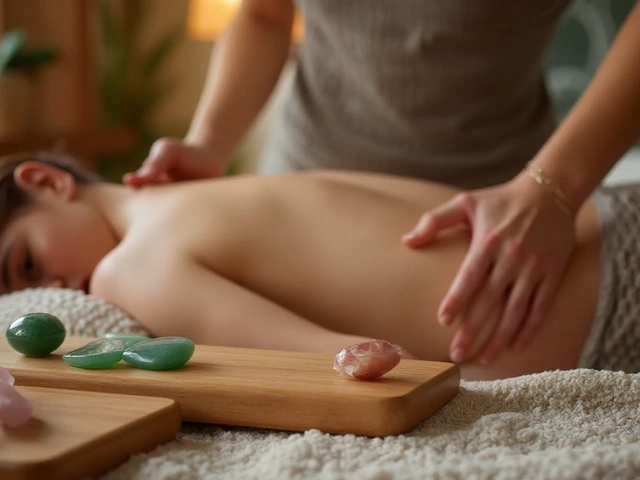Discover the Serenity of Balinese Massage: A Path to True Relaxation

Imagine a place where every touch feels like a gentle breeze on a perfect summer day. That’s the beauty of Balinese massage, an ancient healing practice from the heart of Indonesia. Combining deep tissue, acupressure, and aromatherapy, this massage technique offers more than just relaxation—it’s a holistic journey to balance body and mind.
Originating from Bali, this massage draws from a rich tapestry of influences, including traditional Chinese and Indian therapies. The result is a unique experience that not only eases muscle tension but also helps calm the mind. Whether you've had a stressful week or you just need a moment of peace, a Balinese massage might be the perfect escape.
- Origins of Balinese Massage
- Techniques and Methods
- Health Benefits of Balinese Massage
- Choosing the Right Practitioner
- Incorporating Balinese Massage into Your Lifestyle
- Tips for Maximizing Your Massage Experience
Origins of Balinese Massage
Delving into the origins of Balinese massage is like embarking on a journey through time and culture. This ancient healing practice finds its roots on the enchanting island of Bali in Indonesia, a place renowned for its serene landscapes and spiritual heritage. The essence of this massage is deeply intertwined with the island’s rich tapestry of traditions and rituals.
Balinese massage, a harmonious blend of several diverse influences, dates back centuries. It owes much to ancient Chinese and Indian healing practices, including the principles of Ayurveda and traditional Chinese medicine. These ancient traditions were brought to Bali by traders and travelers who made the island a bustling crossroads of culture and commerce.
In traditional Balinese society, massage was not merely a luxury but a vital aspect of daily life. It was believed to play a crucial role in maintaining physical and spiritual well-being. Healers, known as 'Balians,' passed down their knowledge from generation to generation, blending techniques that worked best to create a unique healing art. These Balians were highly respected members of the community, often serving as spiritual guides and advisors as well.
The practice itself often involves the use of a rich mix of local herbs and oils, aimed at energizing the body and spirit. These ingredients are not chosen at random; they are carefully selected for their therapeutic properties. The use of coconut oil, for example, is prevalent, valued for its ability to moisturize and heal the skin. Similarly, the addition of aromatic essential oils such as jasmine and frangipani is intended to engage the senses and promote relaxation.
According to a study conducted by the Indonesian Institute of Sciences, nearly 70% of Balinese residents still incorporate traditional massage into their healthcare routines. This enduring popularity underscores the deep-rooted significance of this practice in balancing one's energy and maintaining overall health.
"Balinese massage is a perfect blend of ancient healing therapies and modern relaxation techniques," says Dr. Ariani Sugihardjo, a prominent wellness expert in Indonesia. "It reflects a deep understanding of the human body and its needs, honed over centuries.
Today, Balinese massage has transcended its geographical origins and is celebrated worldwide. Spas and wellness centers across the globe now offer this unique form of massage, bringing a piece of Bali’s tranquility to places far and wide. Yet, receiving a Balinese massage on the island itself remains a truly unparalleled experience, a testament to the intrinsic connection between the practice and its place of origin.
Travelers to Bali often seek out traditional massage sessions as part of their immersion into local culture. For many, it becomes a memorable highlight of their trip, a moment of true relaxation and deep cultural insight. Whether practiced by skilled hands in the heart of Bali or adapted in wellness centers elsewhere, Balinese massage continues to be a testament to the island's legacy of healing and wellness.
Techniques and Methods
Balinese massage is a unique blend of various traditional techniques, resulting in a deeply therapeutic experience. The primary methods used are a combination of deep tissue massage, acupressure, and reflexology. This approach ensures that both the superficial and deeper layers of muscles are targeted, providing relief from tension and promoting a sense of overall well-being.
One of the key techniques in Balinese massage is deep tissue work. This involves slow, deep strokes that penetrate muscle fibers to release chronic tension. Practitioners use their thumbs, knuckles, and elbows to work on specific muscle groups, effectively alleviating stiffness and pain. This technique is particularly beneficial for individuals dealing with persistent aches, as it helps improve blood circulation and detoxifies muscle tissues.
Another important method is acupressure. Similar to acupuncture but without needles, acupressure focuses on specific points along the body's meridian lines to balance internal energy, or 'qi.' By applying firm pressure on these points, the massage therapist can unblock energy pathways, leading to a revitalized and harmonious state. This technique not only alleviates physical discomfort but also has a calming effect on the mind, reducing stress and anxiety.
In addition to deep tissue and acupressure, Balinese massage often incorporates elements of reflexology. Reflexology uses targeted pressure on strategic points on the feet, hands, and ears that correspond to different organs and systems within the body. This technique promotes healing and overall wellness by stimulating the body's natural energy flow. For example, applying pressure to the arch of the foot can help improve digestive function, while working on the tips of the toes can alleviate sinus issues.
To enhance the therapeutic effects, aromatherapy is often integrated into Balinese massage sessions. Essential oils, such as lavender, eucalyptus, and sandalwood, are selected based on their healing properties and vaporized during the massage. The inhalation of these beneficial aromas complements the physical techniques, enhancing relaxation and providing a holistic sensory experience.
One visitor to Bali described the sensation as, "like waves of calm washing over every part of my body." The synergy between these various techniques ensures that a Balinese massage is more than just a temporary escape—it's a pathway to long-lasting relaxation and health.
Moreover, the use of traditional Balinese music and ambient soundscapes further contributes to the tranquil atmosphere. The rhythmic melodies and natural sounds help create an immersive environment, allowing the recipient to fully unwind and let go of daily stresses.
Each Balinese massage session typically lasts between 60 to 90 minutes, offering ample time for the therapist to address individual needs and preferences. Whether you're seeking relief from physical discomfort or a mental break, the blend of deep tissue work, acupressure, reflexology, and aromatherapy promises a deeply satisfying experience.

Health Benefits of Balinese Massage
Balinese massage offers a multitude of health benefits that extend beyond mere relaxation. This traditional technique is celebrated for its ability to alleviate both physical and mental stress. One of the primary advantages is its effectiveness in reducing muscle tension. By employing a combination of deep tissue massage and gentle stretches, it helps enhance blood flow and oxygenate muscles, leading to quicker recovery from injuries and less soreness after physical exertion.
Another significant benefit is its profound impact on mental well-being. Balinese massage often incorporates essential oils and aromatherapy, creating a multi-sensory experience that promotes a state of deep relaxation. This can be especially helpful for individuals dealing with anxiety, depression, or chronic stress. The soothing scents used during the massage help release endorphins—nature’s feel-good chemicals—which elevate your mood and induce a sense of calm.
An interesting fact about Balinese massage is its influence on improving the immune system. By reducing stress hormones in the body, it helps strengthen the immune response. This makes your body more effective at warding off illnesses and maintaining overall health. Additionally, regular sessions can improve your sleep patterns. Many people report better sleep quality and fewer instances of insomnia after incorporating Balinese massage into their wellness routine.
Another lesser-known benefit is its ability to enhance skin health. The use of oils and gentle exfoliation during the massage helps remove dead skin cells and moisturize the skin, leaving it glowing and more elastic. Also, the increased blood flow can promote a healthier, more radiant complexion. For those with chronic pain conditions like arthritis or fibromyalgia, Balinese massage offers natural pain relief. The techniques used help to reduce inflammation, providing lasting comfort.
Digging deeper, studies have shown that massage therapy, including Balinese massage, can lower blood pressure and improve heart health. By promoting relaxation and reducing anxiety, it helps keep the heart and circulatory system functioning optimally. According to a study published in the Journal of Alternative and Complementary Medicine, regular massage sessions can significantly lower both systolic and diastolic blood pressure.
"Massage therapy has been proven to reduce symptoms of anxiety, depression, and other mood disorders while enhancing sleep quality," says Dr. Tiffany Field, director of the Touch Research Institute at the University of Miami School of Medicine.
Lastly, Balinese massage has a unique way of boosting energy levels. Unlike other types of massages that might leave you feeling groggy, this particular technique recharges your energy. The rhythmic, flowing strokes stimulate your body’s natural energy centers, leaving you invigorated and ready to face new challenges.
Choosing the Right Practitioner
Finding the right practitioner for a Balinese massage can make a world of difference in your experience. It’s not just about technique, but also about feeling comfortable and secure in the hands of someone who truly understands the art. First, check if the therapist has certifications from reputable schools or training centers. This ensures they have received proper education and training. Don’t shy away from asking about their experience; seasoned practitioners often have a better grasp of addressing specific needs or issues.
Consider the ambiance of the spa or massage center as well. A serene and clean environment enhances the experience and lets you relax more deeply. Look for places that use high-quality natural oils and follow stringent hygiene standards. Reading reviews online can give insight into other people’s experiences, but personal recommendations from friends or family often hold more value.
Communication is key when it comes to choosing your practitioner. A good therapist will take the time to listen to your concerns, understand your health history, and explain the techniques they will use during the session. This dialogue not only builds trust but also helps in customizing the massage to your specific needs. Always make sure to share any allergies or sensitivities you might have to certain oils or scents.
Some people prefer male therapists while others are more comfortable with female therapists. This is a personal choice and it’s okay to let the spa know your preference. Many reputable spas offer the option to choose. It’s also important to check if the therapist respects privacy and professionalism, especially if the massage involves undressing to any degree. Draping techniques should always be used properly to ensure comfort and modesty.
One way to ensure you’ve made the right choice is to schedule a shorter introductory session. This way, you can get a feel for the therapist's technique and approach without committing to a longer session. Pay attention to how you feel during and after the session. A good Balinese massage should leave you feeling relaxed yet invigorated, without any lingering discomfort or pain. According to a study by the National Institutes of Health, clients who had clear communication with their therapists reported higher satisfaction levels.
Lastly, trust your instincts. If something doesn’t feel right, or if you feel uncomfortable at any point, it’s perfectly fine to stop the session. Your comfort and peace of mind come first. In the end, the goal is to find a practitioner who makes you feel safe, understood, and rejuvenated.

Incorporating Balinese Massage into Your Lifestyle
Making Balinese massage a part of your routine can transform not only your physical well-being but also your entire outlook on life. The key is consistency and listening to your body’s unique needs. Whether you’re battling stress, muscle pain, or just need a moment to yourself, a Balinese massage can be the perfect addition to your self-care regimen.
Begin by setting aside a regular time each week for your massage session. This could be a specific day or time, like Friday afternoons or Sunday mornings. Consistency helps your body and mind anticipate and prepare for the relaxation that follows. If going to a spa weekly feels like a luxury, try to aim for at least twice a month. You’ll find that the benefits accumulate over time, making each session more effective.
Another way to incorporate Balinese massage into your life is by creating a serene environment at home. You can do this by using essential oils such as lavender, sandalwood, or jasmine. These fragrances are staples in Balinese massage and can help recreate the experience in the comfort of your own home. Consider diffusing these oils during a hot bath or while you practice yoga. Creating a peaceful ambience can enhance your relaxation experience even outside the professional setting.
Your diet and hydration levels also play a crucial role in how effective your massage sessions are. Drinking plenty of water before and after your massage can help flush out the toxins released during the session, making you feel more rejuvenated. Eating a balanced diet rich in fruits, vegetables, and lean proteins can improve your overall well-being, making your body more receptive to the benefits of Balinese massage.
Regular exercise complements massage therapy wonderfully. Activities such as yoga or Pilates can enhance flexibility and reduce muscle tension, making your massage sessions even more effective. If you’re more into high-impact workouts, a Balinese massage can help speed up recovery and maintain muscle health. By balancing your physical activities with regular massages, you create a holistic approach to wellness that benefits your entire body.
Lastly, it's essential to communicate openly with your massage therapist. Let them know about any specific areas of pain or stress you’re experiencing. They can customize the session to target these areas more effectively. Over time, as you build a rapport with your therapist, they’ll understand your body’s needs better, making each session more personalized and beneficial.
“Balinese massage is not just a luxury but a necessity for mental and physical balance,” says Dr. Priyanka Sharma, an expert in traditional healing practices.
Incorporating Balinese massage into your lifestyle is an ongoing journey, one where you learn more about your body and mind with each session. By creating a regular routine, maintaining a healthy lifestyle, and building a relationship with a skilled therapist, you’ll soon find that this ancient practice brings a new level of serenity and well-being to your everyday life.
Tips for Maximizing Your Massage Experience
A massage can be a heavenly escape, offering relief from the hustle and bustle of daily life. To maximize your Balinese massage experience, consider these tips:
First and foremost, communication is key. Speak with your masseuse beforehand, letting them know about any areas of discomfort or specific needs you might have. This will help tailor the session to your needs, ensuring you get the most out of it. It's not only about relaxation but also about healing and rejuvenation, and knowing what your body requires can make a significant difference.
Arrive early to your appointment. This gives you time to relax and mentally prepare for the healing process. Rushing in at the last minute can increase stress, which is counterproductive to your relaxation goals. Take a moment to sit quietly, breathe deeply, and let go of any tension before the massage begins. Creating a mental space of tranquility helps set the stage for a more immersive experience.
Hydration is vital. Drinking water before and after your massage can significantly improve the outcome. Water helps flush toxins released during the massage, aiding your body in the healing process. Dehydration can lead to muscle cramps and discomfort, which may undermine the benefits of the session. Bring a bottle of water with you, and make a habit of sipping throughout the day.
"No therapy brings you more therapeutically in contact with your body and spirit than a good massage." - Wellness Expert
Consider the time of day when scheduling your massage. Some people find that morning sessions leave them feeling energized and ready to face the day, while others prefer evening massages to help them wind down and prepare for a restful night’s sleep. Listen to your body’s rhythms and choose a time that aligns with your personal needs.
Wear comfortable clothing to and from your session. Tight or restrictive clothing can add unnecessary stress to your body post-massage. Loose, comfortable garments enable your body to continue relaxing even after the massage has ended. Remember, the goal is a prolonged sense of well-being, not just the duration of the massage itself.
Post-Massage Care
After your session, avoid strenuous activities. Allow your body a moment to relish the newfound relaxation and alignment. Gentle stretching or a light, leisurely walk can help your muscles adjust back into daily activities without jarring them.
Finally, establish a regular massage schedule. Whether it’s once a week or once a month, consistent sessions offer cumulative benefits. Regular massages keep stress at bay, improve circulation, and enhance overall health. They also serve as a reminder to carve out time for self-care amidst busy schedules.
To sum up, a Balinese massage can be a transformative experience with the right preparation and care. By following these tips, you can ensure each session is not only relaxing but also profoundly beneficial to both mind and body.





